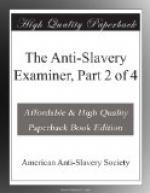Like other Legislatures, Congress has power to abate nuisances—to remove or tear down unsafe buildings—to destroy infected cargoes—to lay injunctions upon manufactories injurious to the public health—and thus to “provide for the common defence and general welfare” by destroying individual property, when such property puts in jeopardy the public weal.
Granting, for argument’s sake, that slaves are “property” in the District of Columbia—if Congress has a right to annihilate property there when the public safety requires it, it may annihilate its existence as property when the public safety requires it, especially if it transform into a protection and defence that which as property perilled the public interests. In the District of Columbia there are, besides the United States’ Capitol, the President’s house, the national offices, and archives of the Departments of State, Treasury, War, and Navy, the General Post-office, and Patent office. It is also the residence of the President, of all the highest officers of the government, of both houses of Congress, and of all the foreign ambassadors. In this same District there are also seven thousand slaves. Jefferson, in his Notes on Va. p. 241, says of slavery, that “the State permitting one half of its citizens to trample on the rights of the other, transforms them into enemies;” and Richard Henry Lee, in the Va. House of Burgesses in 1758, declared that to those who held them, “slaves must be natural enemies.” Is Congress so impotent that it cannot exercise that right pronounced both by municipal and national law, the most sacred and universal—the right of self-preservation and defence? Is it shut up to the necessity of keeping seven thousand “enemies” in the heart of the nation’s citadel? Does the iron fiat of the constitution doom it to such imbecility that it cannot arrest the process that made them “enemies,” and still goads to deadlier hate by fiery trials, and day by day adds others to their number? Is this providing for the common defence and general welfare? If to rob men of rights excites their hate, freely to restore them and make amends, will win their love.
By emancipating the slaves in the District, the government of the United States would disband an army of “enemies,” and enlist “for the common defence and general welfare,” a body guard of friends seven thousand strong. In the last war, a handful of British soldiers sacked Washington city, burned the capitol, the President’s house, and the national offices and archives; and no marvel, for thousands of the inhabitants of the District had been “TRANSFORMED INTO ENEMIES.” Would they beat back invasion? If the national government had exercised its constitutional “power to provide for the common defence and to promote the general welfare,” by turning those “enemies” into friends, then, instead of a hostile ambush lurking in every thicket inviting assault, and secret foes in every house paralyzing defence, an army of allies would have rallied in the hour of her calamity, and shouted defiance from their munitions of rocks; whilst the banner of the republic, then trampled in dust, would have floated securely over FREEMEN exulting amidst bulwarks of strength.




